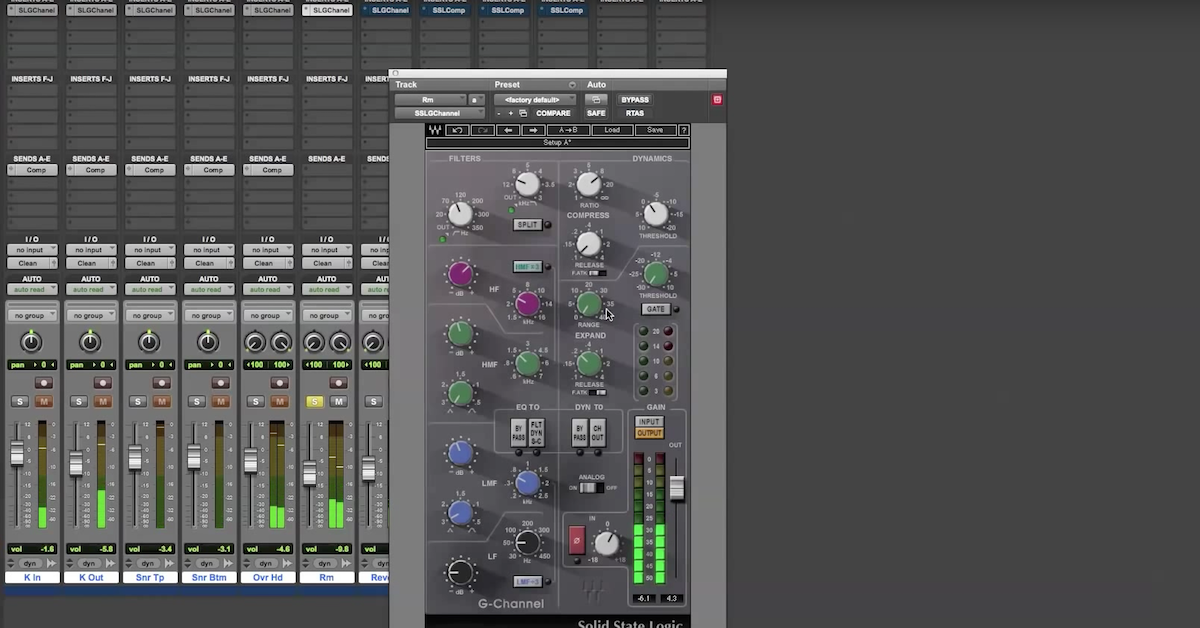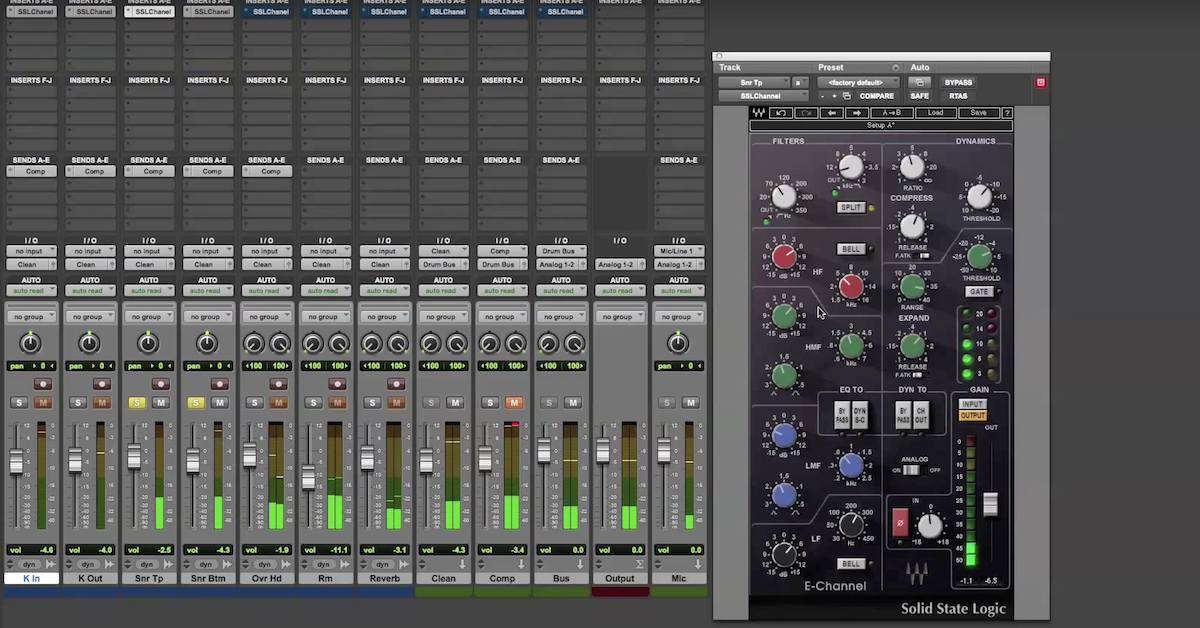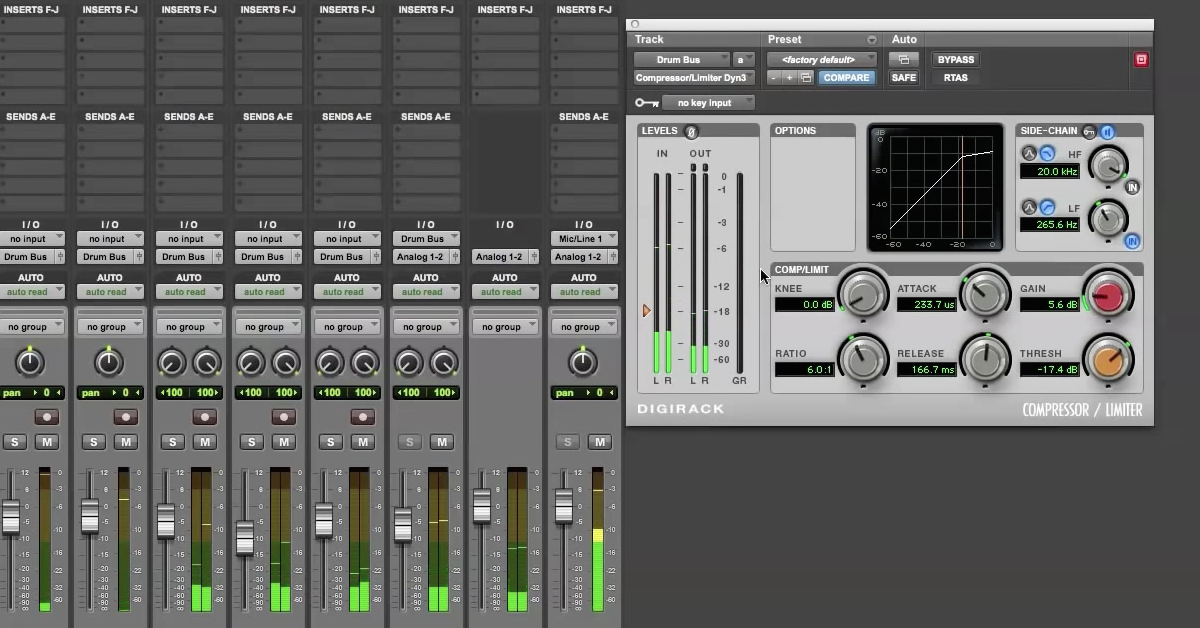How to Use Softube FET Compressor for Mixing Drums
So far, I just have 7 audio tracks here: kick in, kick out, snare top, snare bottom, stereo pair of overheads, stereo pair of rooms, and then a printed outboard reverb audio track. What I’m gonna do is bus these tracks over here, I’m gonna be running parallel compression and I’ll get to that and show you how that’s working. I’m gonna show you how to use the FET compressor to accomplish a nice parallel drum compression sound. And then I’ll have a master drum buss fader that basically controls the output level of the entire drum mix. I’m gonna use the FET compressor here as a limiter.
So, for each of these individual tracks, I’m just gonna show you different techniques that you can use — they’re kind of the standard techniques for these different instruments. I also have a little bit of EQ going on a few different things, but I’m not gonna focus on EQ. Just typical ways of equalizing things like a kick drum or a snare is all I’ve got going on — nothing too fancy.
So let’s get to the compressor. I’ll start out with the kick in mic, show you what I’m gonna do. This is just the initial preset that comes up when you load the plugin. What I’m gonna do for this kick drum is try and use the compressor to emphasize the attack of the hit — of the transient of each drum hit. So, what you do is you play around with the attack and release so you let a little bit of the attack through, and then use the release — watch the gain reduction after each hit. You want the gain reduction to go slowly back to zero on the meter here as a way of controlling so that the compressor is basically squashing the sustain or tail of the drum hit, but allowing the transient to go through, that’s gonna emphasize the attack. So what I like to do is start out — while I’m doing this — Is start out with fast attack, fast release, and adjust it from there.
[kick drum]
So you’ll hear as I pull the attack back, that the transient can now go through. It’s even more obvious when I pull the release back. I don’t need that much gain reduction.
Alright, so now I’ve emphasized the attack of my kick drum. Clipping a little bit, back it off. Alright, let’s move on to the kick out microphone. What I’m gonna do here is the opposite — I want to emphasize the sustain. I want to squash the transient, so what I’m gonna do is fast attack/fast release, kick up the input, squash the transient. Maybe even a higher ratio. And then blend these two together: kick in and kick out, until I’ve got a nice balance of sharp attack and also sustain. And you can kind of adjust these depending only our song if you have more music going on later.
[snare]
Similar sort of thing with the snare, except for the top what I’m gonna do is emphasize the sustain, is I’m gonna do fast attack, fast release. Kind of a lower ratio. Bring out the sustain a lot. So I’m really bringing out the sustain there with the compressor. Just like the kick, I’m gonna use the bottom mic, and what I’m gonna do actually here is try to emphasize the snap like I did with the kick in mic, letting the transient pass.
[drums]
A cool thing you can do is the Softube FET compressor adds some analog color or flavor even if you’re not using the compressor. So what you can do is switch on 1 to 1, so it’s not gonna do any compression, it’s just gonna add that little bit of — that analog color that comes from just running signal through the unit. The hardware unit has a specific sound to it, and Softube has modeled that. I should mention here that the typical 1176-style compressor has buttons for each of these ratios: 4:1, 8:1, 12:1, 20:1, and then all buttons in mode is the other thing. And I’m gonna use the all buttons in mode on my room mic, because that’s a typical classic way to use the all buttons in, for the room mic. One cool thing that Softube has done, is rather than have buttons is you have a variable dial that you can between each of these settings. S I’m gonna boost this up. Don’t need a lot of it, it’s already dramatic enough. You can hear what I’ve done. Really emphasizing the room, bringing out that smash in it. That’s right.
For my printed reverb, I don’t really want any compression going on here, so just as before, I’m gonna go to 1:1 for that. Same with my parallel compression. What I have here with the FET compressor, the first one, is 1:1 so I’m doing no compression. I’m just gonna let it pass through the compressor. My parallel compression, again I’m gonna kind of use a higher ratio — really try and smash it.
One cool thing that Softube has done is allow you to have a detector — sidechain detector. So what I’m hearing is the kick drum is kind of causing the compressor to overreact so I’m gonna use a low cut so that the compressor doesn’t react as much below 200 Hz.
Alright I like what that’s doing. Mix these two together without parallel compression. Makes it a little bit more punchy.
Finally, using it as a limiter, I’m gonna use a 20:1 ratio here, fast attack, fast release, back off the input so I’m just getting a little bit of gain reduction. Step up the output, you’ll see my bus here is pretty flat.
And that’s it. Lastly I’ll bypass it and kick it back in so you can hear how it sounds. Just by adding the compressor. What I’ve done is it’s kind of dry, kind of lifeless. In some of these cases i’m overemphasizing what I’m doing with the compressor than you might want to. But you can see how dramatic it is and it gives you that really modern punchy drum sound by using the compressor.





